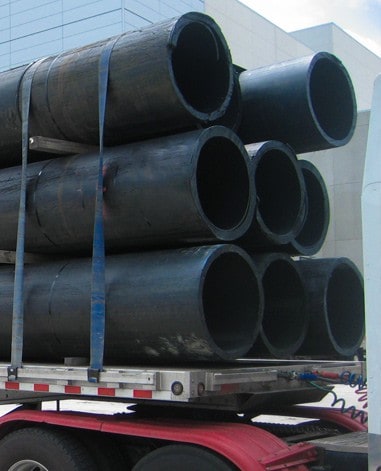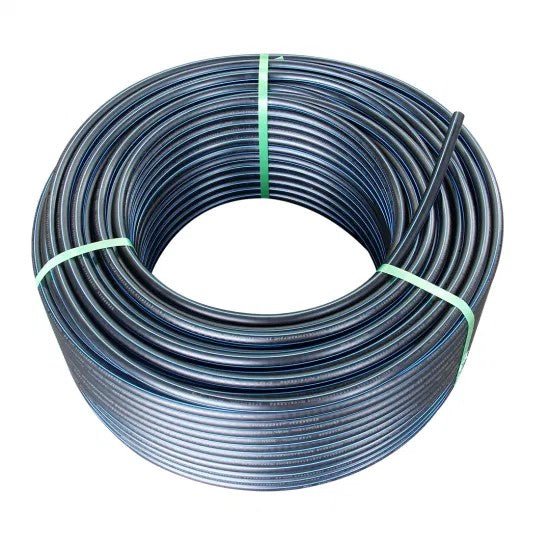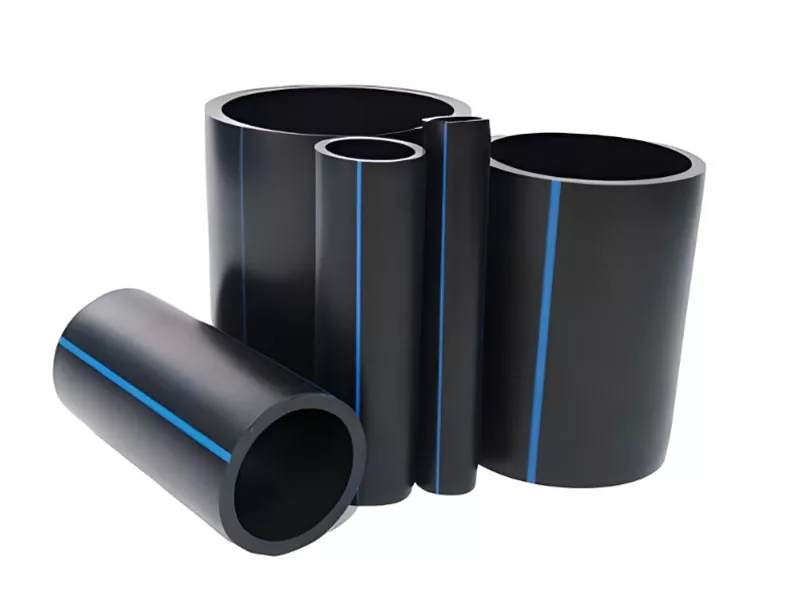Check Out the Manufacturing Refine Behind High-Quality HDPE Pipeline and Its Applications
The production procedure of top quality HDPE pipes is elaborate and methodical. It begins with the choice of basic materials that boost efficiency. Following this, ethylene goes through polymerization to form resin, which is after that formed through extrusion. Quality assurance is vital, making sure that the end product fulfills rigid standards. The journey of HDPE pipes does not finish with manufacturing. Their applications across different sectors reveal a broader importance worth examining.
Recognizing HDPE: Qualities and Advantages

High-density polyethylene (HDPE) is a flexible polycarbonate recognized for its toughness and resistance to numerous ecological factors. This material shows exceptional tensile stamina, making it ideal for requiring applications. Its low-density structure contributes to a light-weight product, facilitating convenience of taking care of and installment. HDPE additionally showcases exceptional resistance to chemicals, which minimizes deterioration when exposed to severe materials.
The material's low dampness absorption better enhances its durability, making it ideal for usage in pipelines and tank. Additionally, HDPE is immune to ultraviolet (UV) radiation, guaranteeing that products keep their honesty also when exposed to sunshine. Its versatility permits for the production of detailed shapes without jeopardizing stamina. The green nature of HDPE, commonly stemmed from recycled products, adds to its appeal, advertising sustainable techniques in production. Overall, these residential or commercial properties and advantages make HDPE a favored option for various industrial and consumer applications.
Basic Material Option for HDPE Production
The option of resources for HDPE production is vital to validate the final product fulfills the desired specifications and top quality criteria. High-density polyethylene (HDPE) is mostly produced from polymerized ethylene, originated from nonrenewable fuel sources such as gas or crude oil. The top quality of these feedstocks greatly affects the mechanical and thermal residential or commercial properties of the last HDPE.
Additives likewise play a substantial function in boosting HDPE's performance, consisting of anti-oxidants, UV stabilizers, and colorants, which enhance durability and resistance to ecological aspects. The selection process should think about not just the chemical make-up of the raw products however additionally their handling qualities to assure efficient production.
The sourcing of raw materials should prioritize sustainability and conformity with ecological laws, as accountable practices are necessary in today's market. Ultimately, cautious raw material option lays the structure for creating premium HDPE pipelines suitable for diverse applications.
The Extrusion Refine: Shaping HDPE Pipe
The extrusion procedure plays an essential function in forming HDPE pipelines, starting with careful material prep work strategies that ensure suitable flow and uniformity. Equally vital is the design of the die, which straight influences the last measurements and surface area high quality of the pipe. With each other, these elements add significantly to the effectiveness and top quality of HDPE pipeline production.
Material Prep Work Strategies
Efficient manufacturing of HDPE pipelines starts with careful product preparation techniques, specifically the extrusion process. Throughout this stage, high-density polyethylene material is first dried out to eliminate wetness, making sure perfect flow qualities. The resin is then fed right into the extruder, where it undergoes home heating and melting, transforming into a thick state. This heating process is carefully regulated to keep the material's integrity and performance. The molten HDPE is required via a die, shaping it right into a continuous pipe kind. Proper temperature level administration throughout extrusion is important, as it directly affects the product's homes and the end product here high quality. As soon as formed, the HDPE pipe is cooled and reduced to defined lengths, ready for succeeding handling and applications.
Die Style Value
Accuracy in die design plays a crucial role in the extrusion process of HDPE pipelines. The die functions as the last shaping tool, directly influencing the pipe's dimensions, wall surface density, and surface area coating. A properly designed die assurances uniform material flow, decreasing defects such as irregularities and weak spots. The geometry of the die must be enhanced to fit the particular buildings of HDPE, including its thickness and thermal habits throughout extrusion. Furthermore, the cooling price of the product as it goes through the die can markedly impact the pipeline's architectural integrity. Subsequently, buying advanced die modern technology is vital for manufacturers intending to generate high-grade HDPE pipes that fulfill industry criteria and customer expectations.
Quality Assurance Steps in HDPE Production
Although numerous variables affect the high quality of HDPE pipeline manufacturing, effective top quality control procedures are essential to assure consistency and dependability in the end product. Key quality control techniques consist of rigorous material inspection, verifying that the raw polyethylene fulfills recognized criteria for pureness and thickness. During the extrusion procedure, parameters such as temperature, stress, and cooling time are closely monitored to keep dimensional precision and structural integrity
On top of that, post-production testing is crucial; manufacturers commonly perform hydrostatic examinations to assess the pipe's toughness and resistance to pressure. Visual assessments for surface problems additionally boost high quality assurance. Accreditation from appropriate requirements organizations, like ASTM or ISO, gives an extra layer of trustworthiness. By implementing these thorough quality control procedures, makers can decrease flaws, enhance efficiency, and guarantee that the HDPE pipelines meet the specific requirements of various applications, ultimately leading to consumer complete satisfaction and rely on the item.
Applications of HDPE Pipe Throughout Industries
HDPE pipes are utilized across different sectors due to their toughness and flexibility. In water distribution systems, they ensure reliable delivery, while in wastewater management, they give reputable services for waste transport. Furthermore, farming irrigation networks benefit from HDPE's resistance to rust and flexibility, making it an ideal selection for contemporary farming practices.

Water Distribution Equipments
A considerable variety of industries depend on high-density polyethylene (HDPE) pipelines for effective water circulation systems. Understood for their longevity and resistance to corrosion, HDPE pipelines are widely utilized in metropolitan water networks, farming watering, and industrial applications. Their light-weight nature helps with easy handling and setup, decreasing labor costs and time. Additionally, HDPE pipes can suit different pressure levels, making them suitable for both low and high-pressure systems. American Plastics HDPE Pipe for Oilfield. The versatility of the product permits seamless integration right into existing infrastructure, decreasing the requirement for comprehensive excavation. HDPE's resistance to chemical seeping guarantees that the water supplied stays secure and clean, making it a perfect choice for keeping the quality of drinkable water throughout numerous fields.
Wastewater Administration Solutions
Effective water circulation systems also lead the way for cutting-edge wastewater monitoring solutions, where high-density polyethylene (HDPE) pipes play a substantial role. Distinguished for their sturdiness and resistance to deterioration, HDPE pipelines are optimal for transporting wastewater in numerous setups. Their flexibility allows for very easy installment in complex atmospheres, lessening the demand for comprehensive excavation. Additionally, HDPE's smooth interior surface minimizes rubbing, boosting circulation rates and effectiveness. These pipelines are also resistant to chemical leaching, making sure that contaminants do not endanger the surrounding environment. Industries, districts, and treatment centers progressively rely upon HDPE pipes for their reliability and long life, making them a recommended option for modern-day wastewater monitoring systems. This adaptability highlights the vital importance of HDPE pipes throughout countless applications.
Agricultural Watering Networks
Agricultural watering networks benefit significantly from the usage of high-density polyethylene (HDPE) pipes, which give efficient and trusted water shipment to plants. HDPE pipes are lightweight, making them very easy to carry and install, while their adaptability permits for different configurations in varied terrains. These pipelines demonstrate excellent resistance to rust, chemicals, and UV radiation, making sure durability in extreme farming atmospheres. In addition, their smooth interior surface area decreases rubbing loss, enhancing water flow and minimizing energy costs connected with pumping. The long life of HDPE pipelines, commonly going beyond half a century, adds to lower maintenance and replacement expenditures. Farmers progressively depend on HDPE pipelines to improve watering effectiveness and promote lasting farming techniques, inevitably leading to improved crop yields and resource preservation.

Future Fads in HDPE Pipe Technology
As the demand for lasting and reliable facilities expands, developments in HDPE pipeline innovation are positioned to change various markets. Emerging patterns consist of the integration of wise modern technologies, such as sensors and IoT abilities, which help with real-time surveillance of pipeline conditions, lowering upkeep prices and avoiding leakages. Additionally, the growth of advanced manufacturing techniques, such as 3D printing, is making it possible for the production of complex, personalized pipe styles that satisfy specific job requirements.
The focus on recycling and circular economic situation practices is driving the innovation of HDPE pipes made from recycled products, boosting sustainability. Improved jointing methods, such as electro-fusion and mechanical installations, are additionally improving installment efficiency and dependability. The expanding focus on environmental guidelines is pushing manufacturers to take on greener production procedures, guaranteeing that HDPE pipes not just satisfy market criteria however also foster an even more lasting future for framework development.
Frequently Asked Concerns
Exactly How Does HDPE Contrast to Various Other Plastic Products?
HDPE surpasses several various other plastic materials pertaining to longevity, chemical resistance, and flexibility. Its low thickness and high tensile toughness make it excellent for numerous applications, typically surpassing alternatives in both performance and long life.
What Are the Ecological Effects of HDPE Manufacturing?
The ecological effects of HDPE manufacturing consist of greenhouse gas emissions, power intake, and potential contamination from producing procedures. Furthermore, inappropriate disposal can cause soil and water contamination, elevating worries about lasting environmental impacts.
Can HDPE Pipeline Be Recycled?
Yes, HDPE pipelines can be reused. Lots of facilities approve made use of HDPE for processing, transforming it into brand-new products. This reusing adds to sustainability efforts, lowering plastic waste while conserving resources and power in the production cycle.
What Is the Life-span of HDPE Water Lines?

How Do Temperature Variations Influence HDPE Pipe Efficiency?
Temperature variations considerably impact HDPE pipeline performance, influencing versatility and strength. High temperature levels can cause softening, while low temperature levels may create brittleness, eventually affecting the pipeline's sturdiness and suitability for different applications in varied atmospheres.